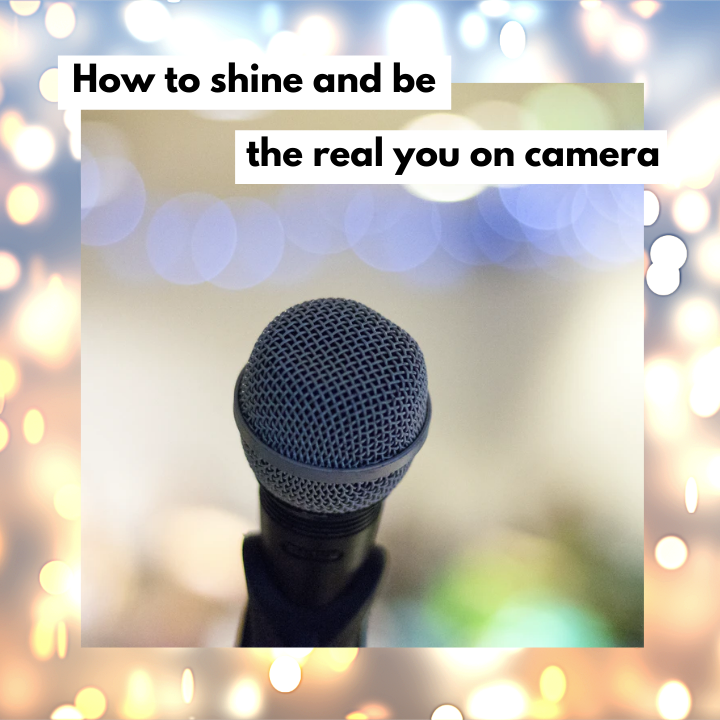
How to shine and be the real you on camera
With meetings, pitches, presentations and events increasingly moving to virtual platforms, we don’t just need to overcome our apprehensions about seeing and hearing ourselves on screen, we need to embrace the technology and learn techniques to be our best selves on camera! In this blog, we’ll be sharing some top tips for gaining camera confidence and knowing how to engage and inspire a virtual audience. For even more on hosting a virtual event, check out Episode 6 from Season 2 of our podcast, Revitalise & Grow.
Be a DIVA!
The DIVA framework is a good point of reference for understanding the basic principles of public speaking on camera.
Dynamic – don’t be boring!
- Without a doubt, gauging energy levels in ‘the room’ is more difficult over camera and there’s a high chance your audience will be muted, have their cameras off and will be more exposed to external distractions. Keep engagement levels high by making your presentation as interactive as possible. Encourage audience participation by using tools such as polls, breakout rooms and chat functions. Ask questions of your audience and use the chat function to gain immediate feedback about your presentation. Most speakers don’t take advantage of these tools, so be brave and use them to stand out from the crowd.
- Nobody wants to listen to a monotone voice from a wooden presenter, so make sure you show your personality and change up the energy from time to time. Try not to script and read your presentation. Instead, have cue cards in-front of you or on a separate screen to refer to. Don’t worry about making the odd mistake – it makes you relatable to your audience and will mostly go unnoticed.
- We all know that movement and body language is a great way to keep an audience engaged, but how is this achieved when only our head and shoulders are visible? Firstly, it’s ok to use hand gestures and to move in and out of the camera, just don’t overdo it! Movement is magnified on screen, so try to keep it purposeful and clear to prevent it from becoming a distraction. Screen sharing is also a great way to create movement and provide a ‘change of scene’ for your audience.
- Don’t forget about eye contact. You may not be able to see all of your audience, but they can all see you, so don’t forget to engage with the lens of your camera. A good way to do this is to imagine a friend or loved one on the lens, rather than focusing on yourself.
Inspiring – connect with storytelling
- Your audience have already been inspired enough to attend your presentation, so there’s no better time to gain their trust in you as an authority on your topic. This becomes easier for them to do if they can relate to you on a human level. Bring your talk to life by telling stories and sharing examples.
- Don’t be afraid to show vulnerability and emotion. Being perfect doesn’t make you relatable, but being honest does. A great tip is to tell a personal story about yourself. By using a personal example, you instantly gain trust and engagement from the audience by demonstrating a genuine understanding of their personal challenge and showing challenges can be overcome. Again, don’t go overboard with this step or you risk losing them. The majority of your presentation should be about your audience and not about you. Think about the language you use – ‘you’ is always far more engaging than ‘I’.
Valuable – be intentional
- Your audience are giving up precious time in their day to learn something from you, so make sure you understand who they are and what they need to hear from you.
- Have a structure to your presentation and don’t waffle. Be clear with the audience from the start. Let them know what they will get from you and make sure you stick to the intention of the presentation throughout.
- A simple structure to follow is:
- Grab their attention and tell them why they should watch
- Introduce yourself
- Give some context
- Share content
- Summarise
- Call to action
Authentic – don’t make it more difficult than you need to
- There is really no need to spend hours writing a script. Choosing to read your presentation will prevent your personality from shining through and will be obvious to your audience.
- As the famous philosopher, Socrates, once said, “Knowing yourself is the beginning of all wisdom.” The only way to be your best self on camera is to be yourself! Let the real you shine through by doing it in your own way and your style.
What about the logistics?
- Think about your camera angle. Your face, head and eyes should be at the same level as the camera and don’t get too close as it can appear intimidating.
- Make sure you have good lighting on your face and don’t sit directly in front of a bright light or window. Putting a lamp on your desk, behind your camera, can make all the difference.
- Choose an appropriate background and make sure you’re somewhere where you won’t be disturbed. You may even want to consider using a virtual background, but do make sure it’s appropriate to your talk and not distracting.
- Your sound quality is more important than your picture. Make sure you have a decent microphone and always be clear and articulate when speaking.
- Don’t switch your camera off when delivering a presentation. Your aim is to make an impact and influence your audience and this is better achieved when you can be seen!
Finally, to let go of those pre-show nerves – stand tall, take a few deep breaths, give your hands a good shake out and tell yourself that you’re about to create something amazing!
For even more tips on hosting a virtual event, listen to Episode 6 from Season 2 of our podcast, Revitalise & Grow and download our FREE guide to hosting a virtual event here!





